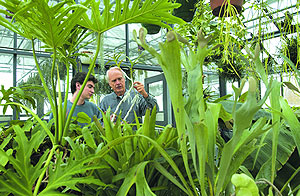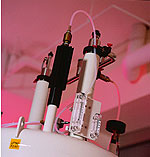

 |
||||
|
The arrangement illustrated one of Kettering's continuing problems--technology was surpassing the building's capabilities. In the Science Center, the cell culture lab is a room unto itself, free from potential contaminants. The ability to conduct research in such areas is key to attracting top science students, says Treichel, who is making strides in examining why cancers become immune to anti-cancer drugs. "High school students who have had advanced biology classes read about these techniques, and they want to be able to do them if they come here," she says. The facility also has a new device called an electroporator,
which zaps cells with electricity. The electricity creates microscopic
pores in cell membranes through which researchers can insert
foreign DNA into cell nuclei during biotechnology experiments.
"We had heat failures in the winter and overheating in the summer," says David Benzing, Danforth Professor of Biology (above). During one unusually troublesome malfunction of the cooling system, Benzing's collection of tropical and desert epiphytes began to succumb en masse. "It fried a third of the plants," he recalls. To cope, Benzing improvised. One summer, he popped some particularly heat-sensitive plants into a makeshift wood enclosure, onto which he hung an air conditioner. The challenge, he said, was not to study the plants in a near-natural environment, but to keep them alive. Oberlin's new 2,000-square-foot greenhouse, which
sits atop the biology research wing, has three sections for
growing plants, each with separate, sophisticated controls for
heat, light, and humidity. Benzing now sets the conditions needed
by the plants electronically, such as hot and dry, hot and humid,
or cool and humid. For the minority of plants that prefer hard
water, there is still Oberlin City water. The remainder are
fed deionized water, which approximates rainwater, from an internal
unit that also serves chemistry laboratories elsewhere in the
building.
"To use an instrument of this magnitude anywhere else, you have to be a graduate or postdoctoral student," says Mehta. Space for the spectrometer--with its requirement of 12 feet of ceiling clearance and a large magnetic field that must be isolated from such disturbances as floor vibrations--was incorporated in the design of the new facilities.
|
|
|

 With
a $500,000 price tag, the spectrometer is the most expensive
instrument the College has owned and is 50 percent more powerful
than resonance spectrometers found at any other liberal arts
college. The workhorse of any chemistry department, says Mehta,
it allows researchers to study the composition and structure
of organic compounds without destroying the sample, as older
methods of chemical analysis require. It can be used for many
kinds of biological and chemical research and allows Oberlin
students to gain graduate-level experience at the undergraduate
level--a huge boost for those vying for spots in the top graduate
and medical schools.
With
a $500,000 price tag, the spectrometer is the most expensive
instrument the College has owned and is 50 percent more powerful
than resonance spectrometers found at any other liberal arts
college. The workhorse of any chemistry department, says Mehta,
it allows researchers to study the composition and structure
of organic compounds without destroying the sample, as older
methods of chemical analysis require. It can be used for many
kinds of biological and chemical research and allows Oberlin
students to gain graduate-level experience at the undergraduate
level--a huge boost for those vying for spots in the top graduate
and medical schools.